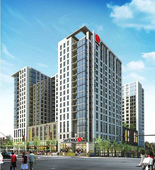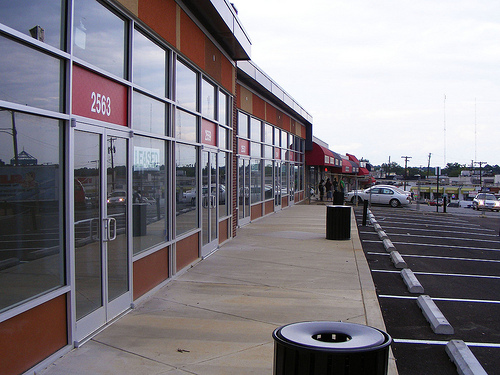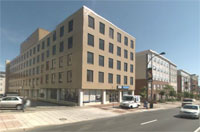How to make Wheaton into the next Adams Morgan (or not)
Wheaton is experiencing an apartment boom, where hundreds of new rentals will be built in the coming years. That’s great for Wheaton, where small businesses will benefit from having more people living in the area, walking around and patronizing their shops.
Developer Leonard Greenberg, who owns over a dozen properties in downtown Wheaton, makes an interesting point about the apartment boom in a Gazette article. Greenberg suggests that with different zoning, Wheaton might become less strip mall and more Adams Morgan:
Leonard Greenberg, chief executive officer of Bethesda-based Greenhill Capital, planned to build 600,000 square feet of shops, apartments and office space in 2004 when he bought property at the intersection of Georgia Avenue and University Boulevard. He said the county council was too slow in approving zoning changes that would have allowed for taller buildings on the property, which is now a row of retail shops with a number of vacant properties.
“To me, Wheaton should be more of an Adams Morgan, more of a village-like environment,” said Greenberg, who added the many apartment projects were an encouraging sign. “The reasons why places like Adams Morgan are popular is that they are high-demand areas where there’s lots of activity. You have young people living in accessible locations. Wheaton needs to be a place where people want to go, not just go to work and leave at the end of the day.”
But let’s be clear: The the real Adams Morgan is shops and restaurants at street level (most of which are locally-owned), apartments above, buildings hugging the street. The result is lots of activity and lots of people, just as Leonard Greenberg describes.
That’s quite different from the things Leonard Greenberg has built. More specifically, below is an image of just one of several one-story, single-use strip malls he’s built around downtown Wheaton over the past 25 years.
I’m sympathetic with Greenberg’s argument that the county dropped the ball on allowing more development in Wheaton when the economy was strong. He understands that you need housing and retail to make a neighborhood vibrant like Adams Morgan.
Nonetheless, Greenberg still went ahead and built not one, but several new retail buildings in downtown Wheaton, all of which have several vacancies and whose former tenants complain of unfairly high rents. That wouldn’t be a problem if, when the market improves, you could just drop apartments on top of his strip malls. But it’s not that simple.
Instead, we have sizable chunks of downtown Wheaton that are stuck as strip malls and parking lots, and which will continue to be until those buildings wear out, which is probably several decades from now.
The Gazette article makes another interesting point about the Computer Building, which is located on Georgia Avenue south of Reedie Drive. Developer Lowe Enterprises wants to convert that building from offices to apartments, which would require displacing current tenants:
Stuart Cohen would have to move his Environmental & Turf Services company, which he said relies on its proximity to the Wheaton Metro station for access to Washington, D.C. Michael Trembley runs the American Career Institute, a vocational school and one of the Computer Building’s biggest tenants. Trembley said finding new office space near a Metro station would be a top priority for the school’s nearly 300 students.
It’s ironic that the move would displace existing offices, given that the county and developer B.F. Saul, which have partnered to develop several acres around the Wheaton Metro station, want to build nearly a million square feet of new offices in the downtown. That space, however, will likely command higher rents than offices in the Computer Building, making it difficult for Environmental & Turf Services or the American Career Institute to relocate there, resulting in a possible net loss of the kinds of business, at least in part, that Wheaton development projects are trying to attract.
Vibrant urban neighborhoods come from a mix of uses like housing, retail and offices. Hopefully, the new Wheaton Sector Plan and zoning code rewrite will allow Leonard Greenberg to build what he wants, not just strip malls.
Vibrant neighborhoods also come from a mix of old and new. If we want downtown Wheaton to become Montgomery County’s answer to Adams Morgan, we should retain existing businesses, be they a pupusa shop or a vocational school. Perhaps the county and B.F. Saul could work out some kind of subsidy for displaced businesses who’d like to locate in a new office building.
If we can do all of these things, we can ensure that Wheaton becomes an even better place to live or visit without sacrificing what already makes it so great.




